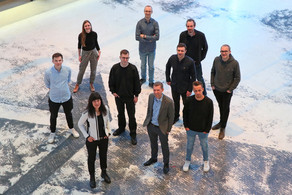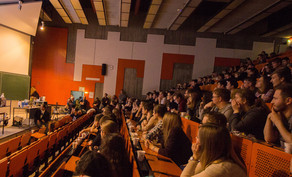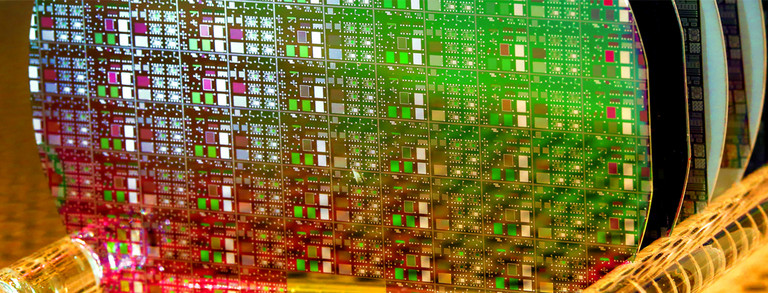Current Projects
Memristor-based Quantum Devices (MemQus)
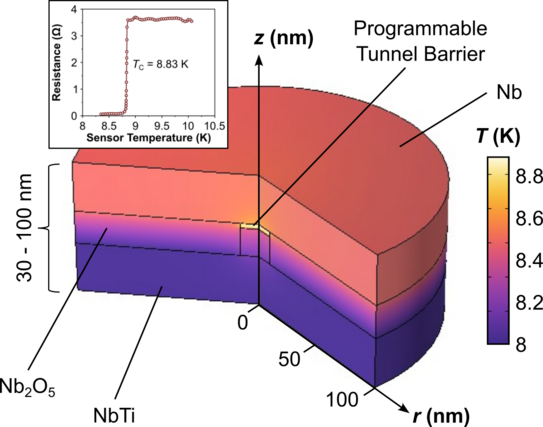
The fabrication of superconducting tunnel barriers with low manufacturing tolerances for applications in quantum electronics is a technical challenge. The MemQus project is one of 15 projects funded for 18 months as part of the EFRE.NRW competition "NRW-Patent-Validierung". The aim of the project is to test an innovative approach to produce novel reconfigurable superconducting tunnel barriers based on memristive-switching oxides with significantly simpler and more cost-effective manufacturing processes.
EFRE.NRW Competition "NRW-Patent-Validierung"
- Title (in German): Memristor-basierte Quantenstrukturen (MemQus)
- Project Number: IN-PV-2-011
- Project Duraction: 2024 (Planned) -
- Funding: EFRE/JTF-Program NRW 2021-2027


Graphene Based Triple-Gate-Platforms for Novel Tunnel Field-Effect Transistors
Compared to conventional field-effect transistors (FETs), tunnel-FETs (TFETs) allow for inverse sub-threshold slopes below 60 mV/decade at room temperature. Therefore, TFETs have the potential of ultra low-power consumption. Ideally, carrier transport in TFET devices only depends on band-to-band tunnelling and energy filtering in the Boltzmann regime. By applying individual potentials to buried gate electrodes in close proximity, different band configurations along a semiconductor channel region can be electrostatically adjusted to control the tunneling probability. However, to achieve a homogenous electric field distribution along the channel, fabrication of buried and mutually insolated electrodes (buried triple-gate, BTG) can be challenging for planar processes. In this project we propose a novel concept of a graphene-based BTG platform for TFET characterization. The advantage of this concept is that at least one gate-electrode is made of an almost atomically thin graphene layer, which enables fabrication of thin vertically stacked graphene/oxide-heterostructures. The proposed concept allows for sharp electrostatic doping profiles and very narrow band transitions. This in turn, increases the band-to-band tunnelling probability and provides very steep subthreshold slopes in TFET characterization.

We plan to integrate low-dimensional WS2 for fabrication of proof-of-concept TFETs. The devices will be analyzed by advanced characterization techniques, including a dedicated in operando method based on high resolution photoemission electron microscopy (PEEM). Other characterization techniques include 2D Raman Spectroscopy, in situ X-ray photoelectron spectroscopy (XPS), and electrical characterization in a temperature range between 8 K and 500 K. The proposed design is versatile and allows for integration of any semiconducting 1D- or 2D-material.
DFG Research Grants
- Titel: Graphene Based Triple-Gate-Platforms for Novel Tunnel Field-Effect Transistors
- Project Number: 524569125
- Project Duration: 01.10.2023 - 30.09.2026
- Funding: Individual Research Grant
Joint project with Dr. G. Zamborlini (Cinchetti Group, Physics Department)


Memristively Programmable Transistors
The core-element of today’s dominating Flash-memory technology are floating-gate transistors. When designing the gate-dielectric of floating-gate transistors, a tradeoff between fast write-access and long state retention has to be made. We recently reported on a novel prototype of a memristively programmable transistor (memTR). The advantage of memTRs is that the logic state is encoded by nanoionic processes instead of classical charge storage as in case of floating-gate transistors. This offers the potential of fast write-access, long state retention and high programming endurance. A memTR is essentially an innovative combination of a transistor and a resistive switch (also known as memristive switch or memristor) integrated on the transistor’s gate contact. Resistive switches are low-power devices with short programming and write access times. Due to their analogue and non-linear behavior memristive devices are also used in neuromorphic applications. Based on our preliminary proof-of-concept results memTRs will be fabricated, characterized and optimized. We will make use of BEOL-compatible fabrication processes. We will characterize in detail the devices and the operation principle using advanced electrical, spectroscopic and microscopic techniques. These findings will be used for a fundamental understanding of the operation principle of memTRs and for further device optimization. Based on these results we will also experimentally analyze the application potential of memTRs for neuromorphics.
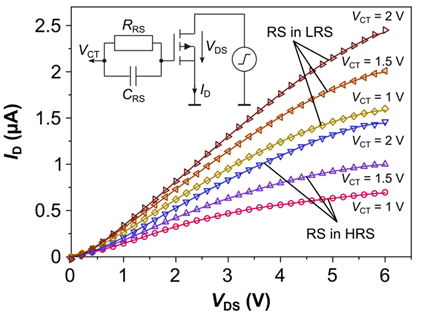
DFG Research Grants
- Titel: Memristively Programmable Transistors
- Project Number: 521341740
- Project Duration: 01.05.2023 - 30.04.2026
- Funding: Individual Research Grant


Memristor-Based Sensors and Metrology
Hydrogen gas sensors have a high technological relevance for the automotive industries. Thin-film technology allows for mass-production of low-priced sensors using established processes that are also used in micro- and nanoelectronics. Disadvantages of thin-film sensors, in particular those for sensing hydrogen, are drift and degradation effects that limit the use in safety relevant applications. In this project, a novel sensor-type based on memristive elements is introduced.
The resistive state of memristive elements can be switched between at least two different levels (high- and low-resistive state). It has been recently demonstrated that the resistance transition is based on complex redox phenomena on the nanoscale and that memristive elements are affected by the ambient. "Memristive sensing elements" (MSEs) will exploit these electrochemical interactions and will be the corner stones for development of novel thin-film sensors. These devices offer the potential that the sensor-functionality can be memristively calibrated, and drift- and degradation effects can be compensated by reprogramming schemes.
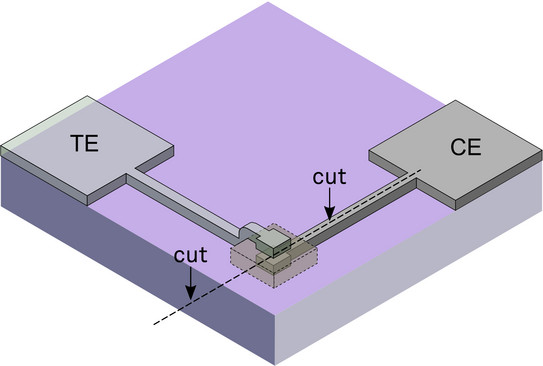
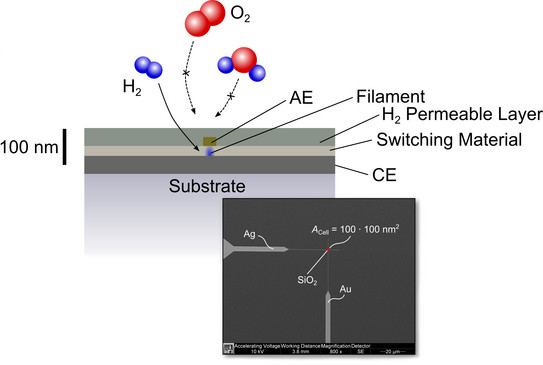
In this project, MSEs will be fabricated and characterized. Advanced electrical, spectroscopic, and microscopic ex situ and in situ metrology techniques will be used to investigate fundamental physical and electrochemical phenomena. Physico-chemical models will be modified and extended based on these results. These findings will be eventually used for fabrication and optimization of low-cost, fast and reproducible memristive sensor elements for hydrogen sensing.
DFG Research Grants
- Titel: Memristor based sensors and metrology
- Project Number: 492026895
- Project Duration: 01.01.2022 - 31.12.2024
- Funding: Individual Research Grant
For more Information please follow the link below:


MEMQuD: Memristive devices as quantum standard for nanometrology
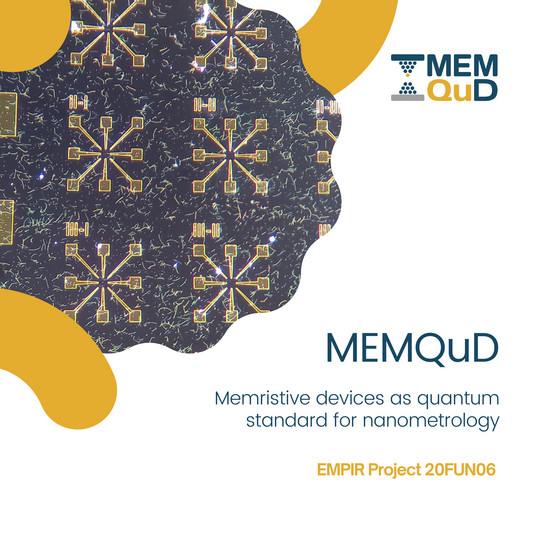

The traceability of physical quantities to natural constants is part of current research in the field of standardization. In memristive systems, quantized conductivity values based on material-independent constants (elementary charge and Planck constant) can be specifically controlled at room temperature. In this project, these quantum effects will be explored with respect to low-cost on-chip self-calibration references.
- Project Number: 20FUN06
- Project Duration: 2021 - 2024
- Funding: Unfunded Partner
For further information please follow the Link below:
Quantum Liouville Equation for Phonon Transport in Integrated Circuits
To enable energy-efficient heat removal in integrated circuits, an accurate understanding of heat transport is important. Thin layers, in particular, play a key role in modern electronic and photonic devices and, due to the quantization effects that occur, are associated with special properties (e.g., higher mobility or lower noise). For analysis, atomistic methods and methods derived from the Boltzmann equation are available, but they are either computationally too demanding or do not account for the quantization effects occurring in thin-film structures. A transport model is to be developed that closes the modeling gap between the atomistic methods prevalent in physics and the conventional circuit-oriented methods prevalent in electronics, so that essential features of heat transport in integrated circuits can be captured efficiently. Ballistic and diffusive processes are to be described adequately, allowing the characterization of time-dependent heat transport parallel (“in-flow”) or perpendicular (“out-flow”) to thin-layer structures. To this end, by analogy with nanoelectronic applications, a transport model for phonons will be developed that is based on a quantum-Liouville-type equation and allows the inclusion of phonon–phonon scattering mechanisms relevant to the existence of heat transport.
DFG Individual Research Grant
- Title: Quantum Liouville Equation for Phonon Transport in Integrated Circuits
- Project number: 528336472
- Project Duration: funded since 2023
- Funding: Individual Research Grant
For further information, please follow the link:


Development of Density-Matrix Equations for Photons to Describe Electromagnetic Fields in Quantum-Mechanical Systems
Quantum effects are gaining importance across applications, including nanoelectronics for miniaturization and quantum computers, photonics for quantum-dot lasers, and optical communication technology for quantum encoding and quantum cryptography. Field operators in quantum field theory allow a precise treatment of particle interactions in the electromagnetic field, but the field is represented by modes as quantized states, so existing numerical methods of classical electrodynamics for solving Maxwell’s equations are not exploited. The mode-analysis approach also requires substantial computational effort. The aim is therefore to advance numerical methods for analyzing time-dependent electromagnetic fields with quantization in view. To this end, equations of motion for annihilation and creation field operators will be transformed, using the Wigner formalism, into density-matrix equations for photons, enabling a self-consistent treatment of charge-carrier transport.
DFG Individual Research Grant
- Title: Development of Density-Matrix Equations for Photons to Describe Electromagnetic Fields in Quantum-Mechanical Systems
- Project number: 550317433
- Project Duration: funded since 2024
- Funding: Individual Research Grant
For further information, please follow the link:


Development of Discontinuous Galerkin Methods Applied to the Liouville–von Neumann Equation
The study of transport behavior within components of nanoelectronics and nanophotonics places high demands on methodological accuracy to describe realistic scenarios based on coherent or incoherent effects. Building on the Liouville–von Neumann equation in center-of-mass coordinates, a finite-volume technique enables the numerical treatment of stationary and transient transport processes, including complex potentials for open structures. By choosing a suitable basis in the approximation, a phase-space representation can be used to capture scattering mechanisms. This permits a more flexible implementation of transient algorithms compared with nonequilibrium Green’s function approaches and avoids the drawbacks of common methods for solving the Wigner transport equation that rely on discrete Fourier transforms. The discontinuous Galerkin method as a numerical scheme has been advanced in many research fields in recent years because of its high order of approximation and numerical efficiency. This methodology has not yet been applied to the Liouville–von Neumann equation. Compared with existing methods, it would achieve further efficiency gains and a markedly improved description of many interaction effects, for which a pronounced reduction of numerical dispersion to avoid phase errors is essential. The aim is therefore to develop a discontinuous Galerkin method for solving the Liouville–von Neumann equation such that it can also be extended to other important applications, for example spintronics or phonon transport.
DFG Individual Research Grant
- Title: Development of Discontinuous Galerkin Methods Applied to the Liouville–von Neumann Equation
- Project number: 446321675
- Project Duration: funded since 2021
- Funding: Individual Research Grant
For further information, please follow the link:



